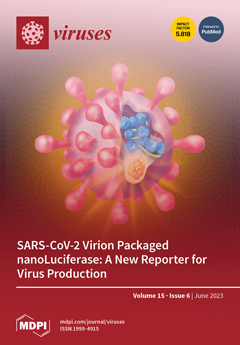Salt mines are a special type of hypersaline environment. Current research mainly focuses on prokaryotes, and the understanding of viruses in salt mines remains limited. Understanding viruses in hypersaline environments is of great significance for revealing the formation and maintenance of microbial communities,
[...] Read more.
Salt mines are a special type of hypersaline environment. Current research mainly focuses on prokaryotes, and the understanding of viruses in salt mines remains limited. Understanding viruses in hypersaline environments is of great significance for revealing the formation and maintenance of microbial communities, energy flow and element cycling, and host ecological functions. A phage infecting
Halomonas titanicae was isolated from Yipinglang Salt Mine in China, designated
Halomonas titanicae phage vB_HtiS_YPHTV-1 (YPHTV-1). Transmission electron microscopy revealed that YPHTV-1 had an icosahedral head with a diameter of 49.12 ± 0.15 nm (n = 5) and a long noncontractile tail with a length of 141.7 ± 0.58 nm (n = 5), indicating that it was a siphovirus. The one-step growth curve showed that the burst size of YPHTV-1 was 69 plaque forming units (PFUs) cell
−1. The genome of YPHTV-1 was 37,980 bp with a GC content of 36.2%. The phylogenetic analysis of the six conserved proteins indicated that YPHTV-1 formed a cluster with
Bacillus phages and was separated from phages infecting
Halomonas. The average nucleotide identity (ANI), phylogenetic, and network analyses indicated that the phage YPHTV-1 represented a new genus under Caudoviricetes. In total, 57 open reading frames (ORFs) were predicted in the YPHTV-1 genome, 30 of which could be annotated in the database. Notably, several auxiliary metabolic genes were encoded by YPHTV-1, such as ImmA/IrrE family metalloendopeptidase, mannose-binding lectin (MBL) folding metallohydrolase, M15 family of metal peptidases, MazG-like family protein, O antigen ligase, and acyltransferase. These genes potentially enabled the host bacterium to resist ionizing radiation, ultraviolet light (UV), mitomycin C, β-lactam antibiotic, high osmotic pressure, and nutritional deficiencies. These findings highlight the role of haloviruses in the life cycle of halobacteria.
Full article






